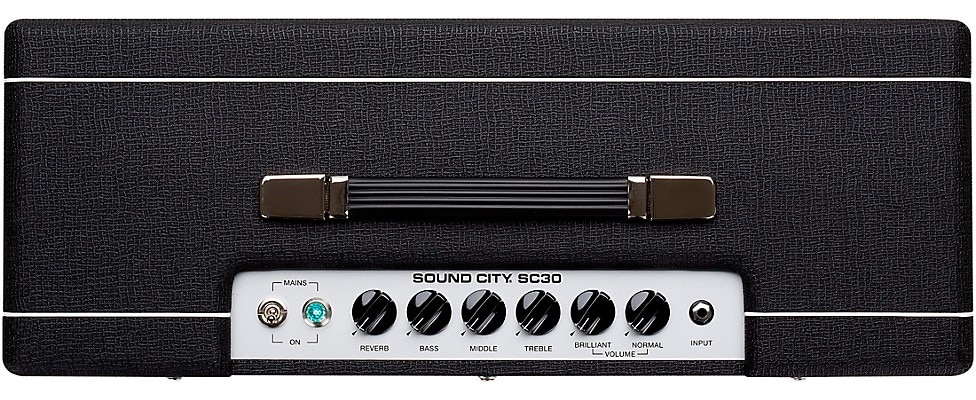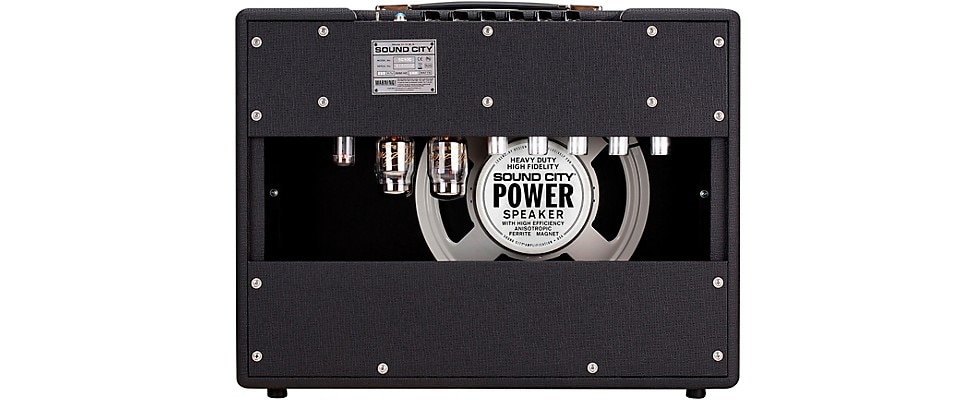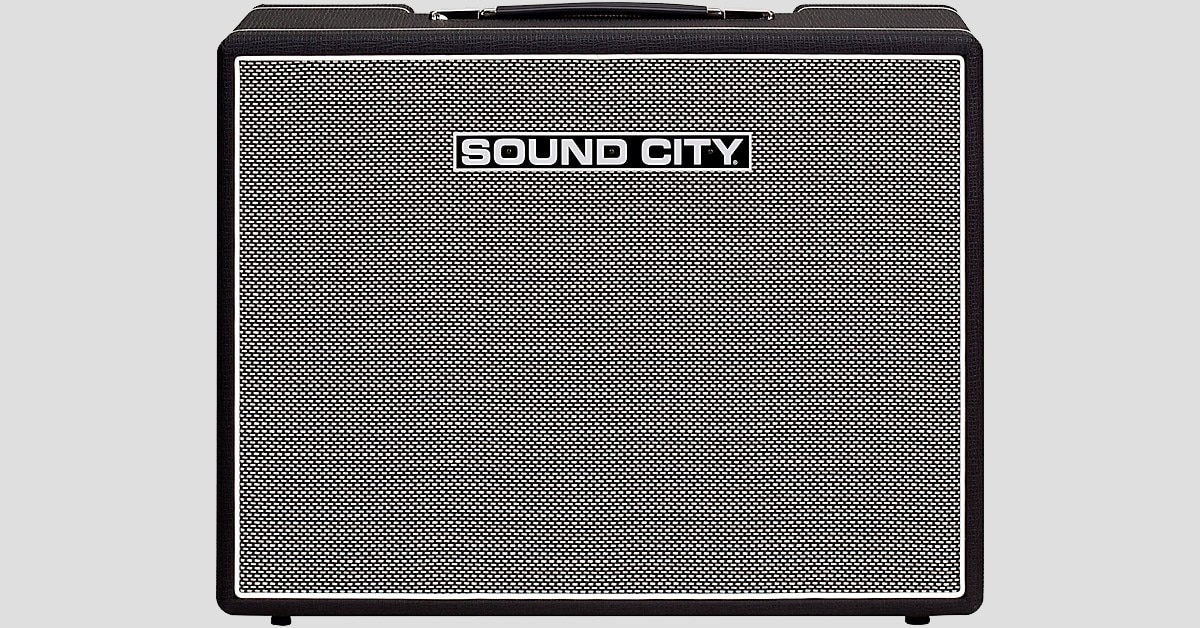We go hands-on with the new Sound City Amplification SC30 guitar amplifier
Written by George VanWagner, Musician's Friend Staff Writer
Just a short while ago, I had the chance to spend some time with the Sound City SC20, a 20W, all-tube combo that was designed by Steven Fryette (of Fryette amps and original founder of VHT amps). So, when I had to chance to take a closer look at their SC30 combo amplifier, a slightly bigger brother to the SC20 that, while sharing preamp architecture, is a very different beast, indeed.
Fryette’s love for the amp designs that Dave Reeves did for Sound City and, later, for Hiwatt, is what inspired him to start building guitar amps. The recent reboot of the Sound City brand is intended to advance Reeves’ work by providing amps that deliver punchy, powerful sound that moves easily from clean to overdriven to classic rock distortion.
In considering this amp, let’s start at the beginning of the signal flow. Both the SC20 and SC30 have the same basic front end. A single channel with a single input, but two volume controls — Normal and Brilliant — with Bass, Mid and Treble tone knobs and a tube-driven, 3-spring Accutronics reverb tank, offers a wide range of tonal options.
Why two volume knobs for a single input, you ask? It’s a great way to add what a photographer would call “depth of field” to your sound. The guitar input is split to feed both volume knobs, and the signal is remixed afterwards. The two sections are voiced differently. The Normal control has a deeper low end and a little more high-end sparkle, with a smooth, fat tone when it’s driven into distortion. The Brilliant control carries a little more gain and rolls off some lows and highs for a tonal focus that shifts from upper midrange in its clean range to a throatier, low-mid growl when pushed into distortion.

This dual-section design offers a number of very cool possibilities for dialing in great guitar sound. You can push one fairly hard, and keep the other clean for a mixture of precise note articulation and serious crunch. You can add or subtract some upper-midrange emphasis with the Brilliant knob. The amp also delivers a great “woman tone” when you roll back your guitar’s tone knob and push the Brilliant side up. It’s a clever scheme that delivers a lot of versatility without fancy channel switching or other added hardware.
As I mentioned in my review of the SC20, the reverb is very effective and musical, with the knob ranging from subtle hints to fully awash in ambient madness. A great spring reverb makes any amp sound just that much cooler, and this one certainly qualifies.
Coming to the power section, we see what makes for the big difference between the SC30 and its smaller sibling. Where the SC20 has a solid-state rectifier and a pair of fixed-bias 6V6 output tubes, the SC30 uses a 5AR4 tube rectifier and a cathode-biased (also known as self-biased) power section that can use either the matched Genelex Gold Lion KT66 output tubes it comes with , or a pair of 6L6, 5881, or other equivalent output tubes without the need for re-biasing the amp.

So what are the differences sonically? To begin with, the rectifier, even though it’s not actually in the signal path, can have a subtle effect on both the sound and feel of an amp. A tube rectifier can provide what’s known as “sag” when there’s a momentary demand for more voltage than the tube can deliver. It’s almost like a mild (or, in extreme cases, not so mild) compressor on a note or chord’s attack with a following “bloom” as the voltage catches up with the demand. Too much sag and the amp can feel unresponsive, but add just enough and it provides a dynamic tool that is an integral part of the rock-and-roll vocabulary.
The power section is a cathode-biased, push/pull design — a configuration that has come to commonly be referred to as Class-A, although it really isn’t (explaining the whole amplifier class thing would take a whole other article, though, and that’s not what we’re here to do today). What this means to the non-technically inclined is that the amp moves very smoothly from clean to overdriven to full-blown distortion and has great dynamics. It also means that it’s a lot louder than you would normally expect a 30W 1x12 amp to be, especially if you want to really crank it, but in volume-sensitive situations, like small clubs or home studios, it matches well with an attenuator like Fryette's Power Station. It has the slightly “squishy” feel that amps of this design tend to have when pushed hard, and, for classic rock, Americana, country, blues and jazz, that’s a good thing. That give and take with the amp is a part of the conversation you and your instrument carry on (and, like Fryette, I consider the amp to be a part of the entire instrument you play as an electric guitarist). The custom ferrite (ceramic) speaker from Fane is voiced like a classic British 12”, but with an open midrange clarity and without high-end "fizz".
The other benefit of this particular cathode-biased design is the ability to swap output tube types between KT66, 6l6 and 5881 tubes, each of which has a distinctive tone, although the KT66 pair has a unique beauty that this design brings to the fore. This adds another layer to the ability to dial this amp in precisely to the tone that works best for you. You’re not going to be swapping out tubes in the middle of a gig to change the tone — like all amps of this design, it runs hot — but it’s certainly worth spending some time to determine if one of the other tube sets would work better for your particular style.
A quick word about the manual. Read it. No, seriously. The amp can do a lot of things for such a simple setup, and the manual is excellent at explaining what’s what, and how to dial in certain types of sound. As someone who used to write manuals, I appreciate a good one when I see it, and this one is a huge help.
Like the SC20, I found this amp to be a huge amount of fun to play across my usual range of material, from blues and roots music to my psychedelic acid jazz band, with fat, smooth, singing distortion and nice, spanky cleans. It was great both just plugging straight in or with a fairly complex pedalboard. It makes boosts, overdrives and distortions sing, and, because the amp is designed to break up primarily in the power section, the input section design keeps the shimmer in ambient effects without turning them into mud. If you’re looking for an amp that can dial in your sound and become a natural-feeling extension of your guitar, the SC30 is a great place to land.
A couple of notes on the accompanying recordings. All tracks were recorded in Logic Pro X through the inputs of a Focusrite Saffire Pro24DSP audio interface with the internal DSP disabled. No post effects or processing were added. A CADLive D80 dynamic mic was placed 1” from the grille, aimed at the juncture of dust cap and cone, and a CADLive D82 ribbon mic was 6” from the grille, aimed about a third of the way in from the outer edge of the cone. Guitars used were a ’65 Stratocaster with noiseless pickups, a 1995 Fender Japan ‘50s Tele with Seymour Duncan Antiquity pickups, and a stock Steinberger Spirit GL.






































































































































